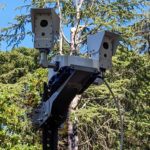San Diego Country Estates has been chosen as the location of a new early fire detection device.
Delphire Inc. has received a $25,000 grant from the Caltech Rocket Fund that will be used to cover the cost to deploy a Sentinel FD3 unit in Ramona, said Delphire CEO Gilberto DeSalvo. The device was manufactured in Yuma, Arizona and will be assembled in Pasadena this week.
DeSalvo said he’s hoping to have the device deployed as early as August.

The Sentinel FD3 device offers three main detection methods for fire. The first is a visible camera similar to ones found on Ring doorbells that can identify fires through the use of customized AI with a range of up to a mile, DeSalvo said. Thermal cameras are also used to pick up on any smoldering around the area within a shorter range than the first camera. The third detection method is a mechanical sensor that looks for smoke in the area.
A processing system is constantly at work within the device, similar to a cell phone, according to DeSalvo. Once something out of the ordinary is identified, the Sentinel FD3 can send a picture, infrared image and related data gathered in that moment to any cell phone or computer as an alert.
Randy Lyle, a Julian resident and retired fire coordinator for SDG&E, said the eastern side of San Diego Country Estates is an advantageous area to deploy the unit. There are plans to install more in the future in the same area to create a defensive line to detect fires.
“We’re kind of making an arch coming from the north to the south coming along the eastern edge of the Country Estates,” said Lyle, a consultant for Delphire.

(Gilberto DeSalvo)
The amount of easily ignitable bushes in this area of the Country Estate and its location on the eastern end of Ramona make it a good place to test the instrumentation, Lyle said.
When a fire breaks out the Santa Ana wind typically pushes the flames from the east to the west, Lyle said. He estimates about six devices would be needed to complete the arch around the eastern side of San Diego Country Estates.
“Not to say you can’t have a problematic fire come from the west, but if you were looking at the percentages, the direction where the fire’s going to come from and be the most impactful, it would be from the east,” he said.
Testing in Irvine showed the Sentinel FD3 device can catch ignitions within about 60 seconds of fire being set to brush.
“That’s a different scale because you know where the fire is and you know that it’s a real fire because you’re getting a picture,” DeSalvo said.
Being able to pinpoint a location and send an alert that early is essential to ensuring the initial attack on the fire is successful, Lyle explained. Especially as burning conditions worsen, even a little bit of information could be key to reduce some potential damage a fire would cause, he said.
Delphire has already applied for another grant from OpenIDEO: Climate Resiliency Challenge to produce more Sentinel FD3 units, DeSalvo said. The Climate Resiliency Challenge is an invitation for organizations and teams across the globe to develop solutions that will empower frontline communities to be ready and resilient against disasters caused by climate change — in particular, wildfires, floods, and extreme weather.
Compared to similar devices on the market, the Sentinel FD3 can be manufactured and installed much more affordably, DeSalvo said.
Lindsey FireSense, a company that also produces fire detection devices, charged $1.9 million for 30 of their units last year, or $63,000 per unit, according to a press release. DeSalvo estimated that the Sentinel FD3 devices will arrive at about one third of that cost, around $21,000 per unit, including at least a year of support.
To get the Sentinel FD3 units out on a larger scale, DeSalvo hopes to work with the Ramona community as well as the California Fire Safety Council, San Diego River Conservancy and other government agencies.
If the coverage of the Sentinel devices were to be extended to the entirety of Ramona it would take about 25 to 30 devices, Lyle estimated.
“The cameras and detection and all, they’re the way of the future and they’re here to stay,” Lyle said. “It’s such a multi-purpose, multi-function tool. It’s becoming a pretty big game changer in the fire realm these days.”


